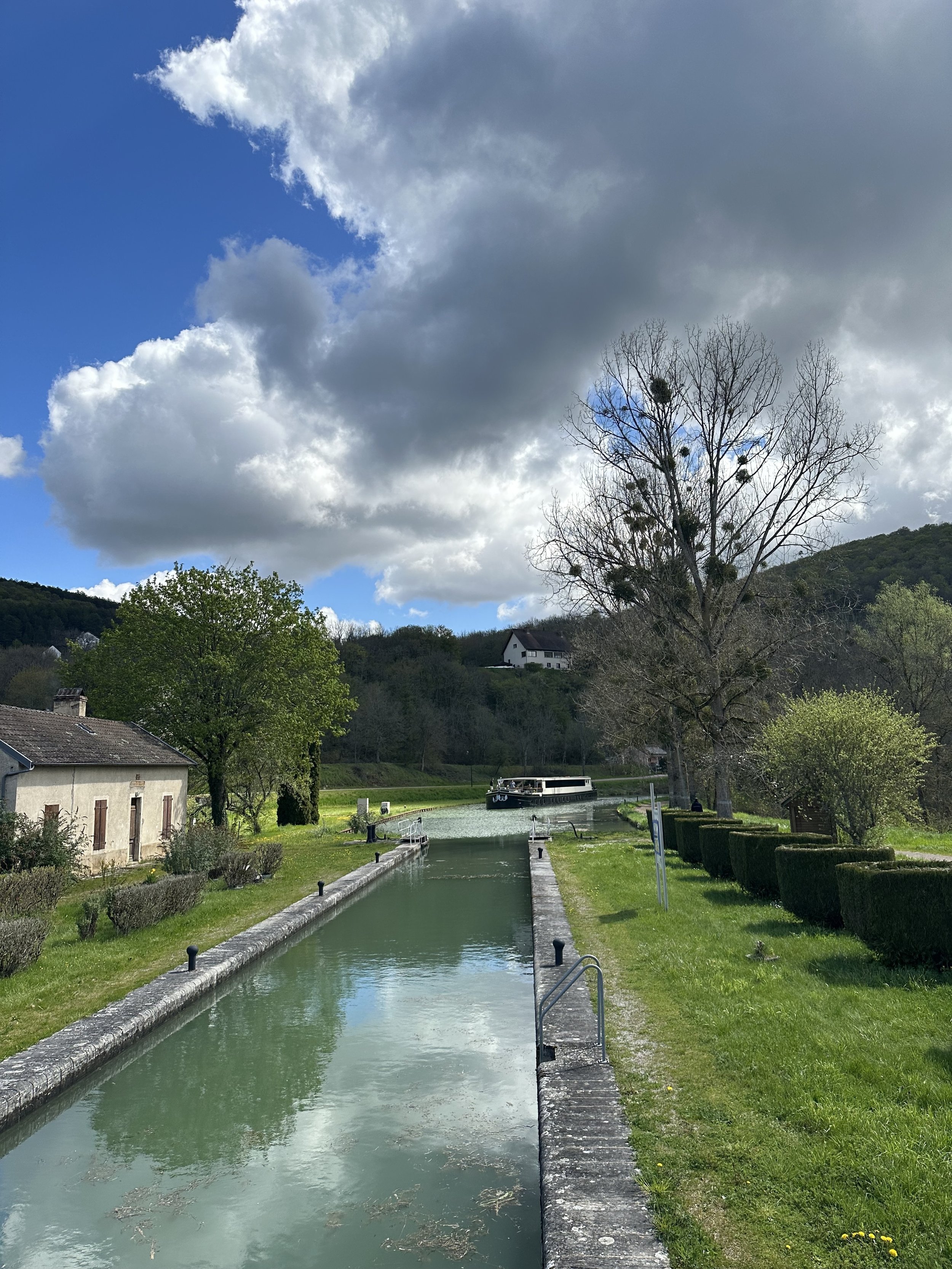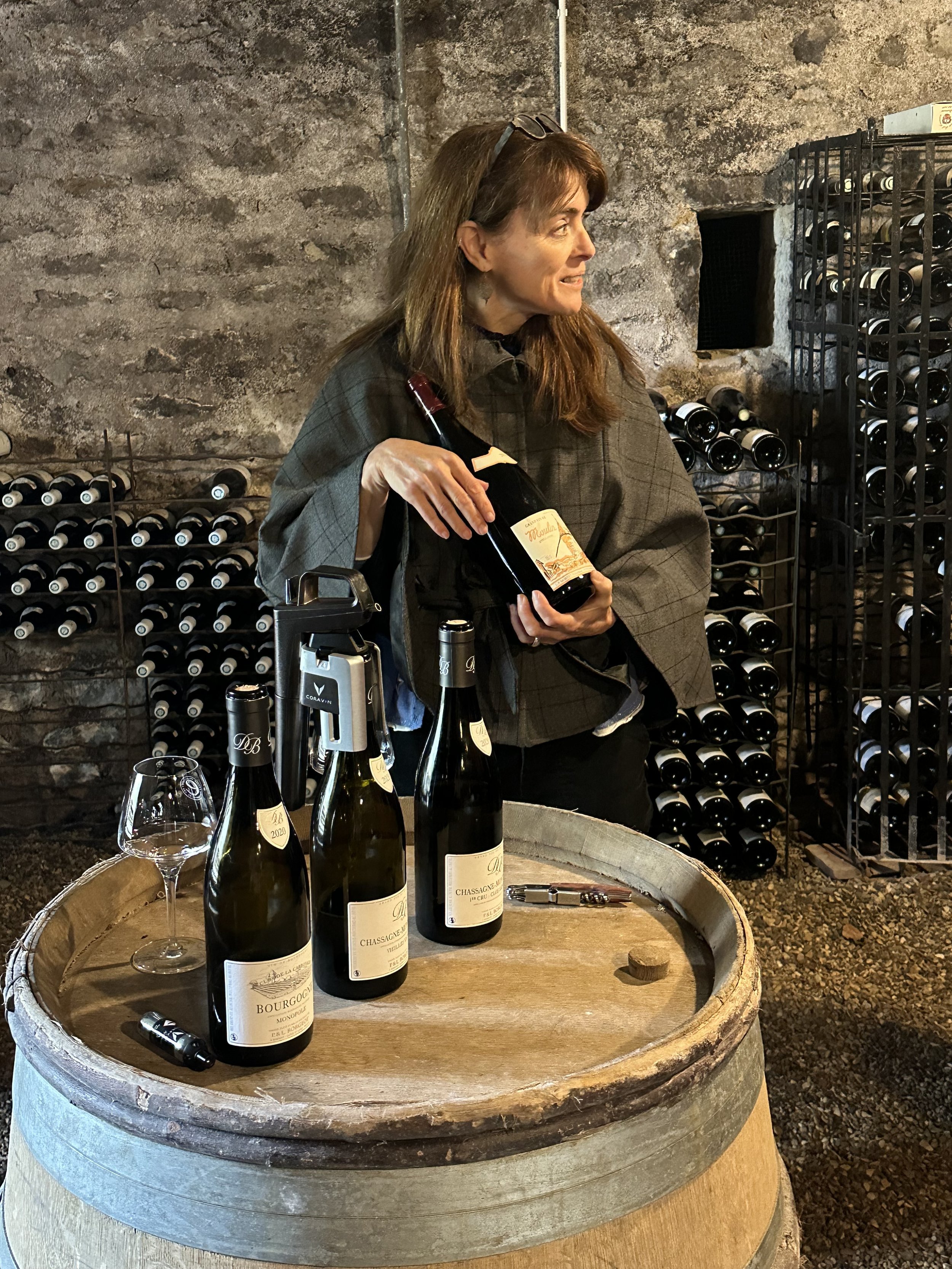3 Wine Experiences on a Burgundy Cruise
Canal in Burgundy
On the beautifully preserved Canal de Bourgogne, barge boats slowly float by some of Burgundy’s most renowned vineyards, markets, and dairies. The canal was already under construction as of 1605 and is part of the link between the English Channel and the Mediterranean Sea. Mules and tugboats once carried wine from some of the world’s most famous vineyards to the markets of Dijon and neighboring England.
I recently returned from a trip on the Grand Cru—a hotel boat—which floats slowly along the towpath organized by the Barge Lady Cruises. It’s ideal for walking and biking past rich farmland and old stone bridges. It has an open kitchen so guests can watch local dishes come to life, and a cellar stocked with Grand Crus and other treats from the region. I visited the famous market in Dijon, the vineyards of Domaine Pierre Amiot, and the Chateau du Clos de Vougeot, where Cistercian monks made wine in the 12th century. To say it was an epic trip barely scratches the surface.
Cheese plate on board
It was the first time I left my two little kids for more than a weekend, and it was probably the best possible way to do so. Exhausted from the relentlessness of taking care of others, I felt beautifully, blissfully taken care of. I awoke to leisurely breakfast of flaky croissants and custardy herb-strewn scrambled eggs. When I needed to teach a class via Zoom, the captain drove me to a private room in the Abbaye de la Bussière, an ancient Cistercian abbey converted to a luxury hotel with a Michelin star rated restaurant. After, we stayed for dinner where perfect circles of pasta were filled with a bounty of morels.
I drank amazing, sometimes surprising, wine each day. From the comfort of our little, gorgeous boat, I got a hands-on (glass on!) lesson about the region of Burgundy, aka “Bourgogne,” which is a small region with an outsized influence on the world of wine.
Here are wine-related highlights:
Fall in Love with Crémant de Bourgogne
Crémant de Bourgogne
I’m a lover of bubbles, and the local bubbly proved consistently easy to drink and delicious. Burgundy’s Crémant is categorized as a regional-level wine, made with grapes from Bourgogne appellation vineyards, and it tasted like the terroir, which is to say like the region’s famous wines —fruity, bright, and fresh.
Made in the traditional method, just as in Champagne, these wines are relatively excellent value. My favorites had a green apple crispness and that pleasant, toasty note of fresh-baked brioche. I’ve been drinking them back at home, as a festive start to any meal or paired with a bold Burgundian cheese like Epoisses. The delicate bubbles cut through the rich, pungent cheese.
My favorites include the vanilla and citrus brightness from Maison Louis Picamelot and the Bailly-Lapierre’s rose Cremant, with strawberry shortcake notes and a tart finish.
Discover Grand Cru wines at Domaine de Cromey
Domaine de Cromey
The sprawling Domaine de Cromey sits among the vines just south of Beaune. Since the late 1600s, the locals have called it the ‘chateau’, and the Lords of Cromey used the land for making wine and hosting parties. Touring the bucolic groves was lovely, but I got butterflies as we descended into the musk of the wine cellar. Our host walked us through a tasting of three wines made with the same grapes in the same plot of land made by different winemakers, then of different vintages. We got to taste the way the raw material of the grapes and the land could be transformed by different makers—and then by time.
I learned that it’s the plot of land itself that connotes the distinctions that make their way onto the bottles in Burgundy: of the more than a hundred wine-growing sections (or climats), just 1% are grand crus, 10% are premier crus, 37% are village wines and 52% are regional wines. While Grand Crus certainly carry hefty price tags, they are not necessarily more tasty—just different. They are wine for a special occasion. The village or regional wine you might select for an everyday dinner might still be especially gorgeous.
Domaine de Cromey doesn’t offer their own estate wines but serves as the headquarters for BurgundyWine.com which offers local small production wines online. I found Domaine Oudin Chablis 2021 and Gabin and Felix Richoux Irancy “Veaupessiot” 2018 to be standouts.
Domaine de la Romanée-Conti by Anna & Michal is licensed under CC BY 2.0.
Celebrate Wine History in Beaune
Our final excursion was to charming Beaune, the capital of Burgundy wines. Halfway between Paris and Lyon, its historic heart beats to the rhythm of wine. We took a tour of the Hospices de Beaune, a meticulously preserved medieval hospital, founded in 1443 with its famous brightly colored, geometric patterned roof tiles. It’s also the home of the world’s most famous charity wine auction, which has been raising money through the region’s fine wines since 1859.
We stopped by the Cross of Romanée-Conti, one of the world’s most prestigious vineyards, renowned for producing some of the most expensive red wines in the world. We toured ancient wine presses and walked through the rambling Clos-de-Vougeot, a vineyard created in the 12th century by Cistercian monks.
Beaune Hôtel des ducs de Bourgogne 554 by GFreihalter is licensed under CC BY-SA 3.0
At the Musée du Vin de Bourgogne, in the former Palace of the Dukes of Burgundy, a comprehensive depiction of the region’s wine-making process from antiquity to modern times shows just how deeply wine is connected to the soul of Burgundy. Wine is everywhere in Burgundy—past, present, future. On the peaceful canal, it transported me to a place of calm, beauty, rich tradition, and delicious possibility.






